Comprehensive Analysis of Financial Reporting and Conceptual Framework
VerifiedAdded on 2022/11/13
|7
|1169
|398
Report
AI Summary
This report provides a comprehensive overview of financial reporting, focusing on the conceptual framework established by global accounting regulators like IASB and IFRS. It details the objective of financial reporting, which is to assist stakeholders in making informed decisions about business entities. The report examines qualitative features of useful financial information, the components of financial statements, and the role of financial instruments. It explores the processes of recognition, de-recognition, measurement, presentation, and disclosure of financial elements, highlighting the nuances and implications within the framework. The report emphasizes the importance of IFRS in setting global standards and ensuring prudent financial reporting, with references to the revised Conceptual Framework for Financial Reporting issued in March 2018.

Financial Reporting
1 | P a g e
1 | P a g e
Paraphrase This Document
Need a fresh take? Get an instant paraphrase of this document with our AI Paraphraser
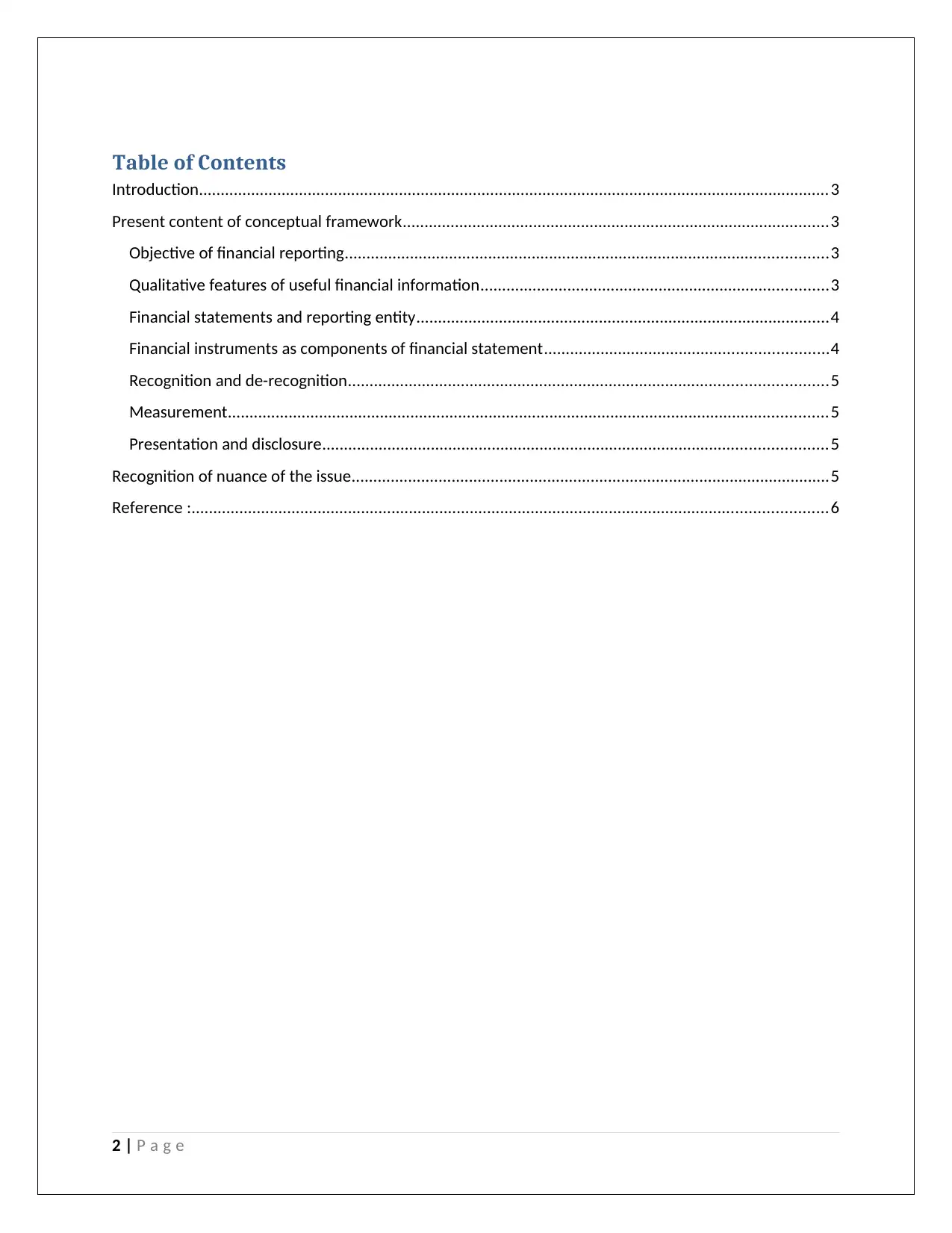
Table of Contents
Introduction.................................................................................................................................................3
Present content of conceptual framework..................................................................................................3
Objective of financial reporting...............................................................................................................3
Qualitative features of useful financial information................................................................................3
Financial statements and reporting entity...............................................................................................4
Financial instruments as components of financial statement.................................................................4
Recognition and de-recognition..............................................................................................................5
Measurement..........................................................................................................................................5
Presentation and disclosure....................................................................................................................5
Recognition of nuance of the issue..............................................................................................................5
Reference :..................................................................................................................................................6
2 | P a g e
Introduction.................................................................................................................................................3
Present content of conceptual framework..................................................................................................3
Objective of financial reporting...............................................................................................................3
Qualitative features of useful financial information................................................................................3
Financial statements and reporting entity...............................................................................................4
Financial instruments as components of financial statement.................................................................4
Recognition and de-recognition..............................................................................................................5
Measurement..........................................................................................................................................5
Presentation and disclosure....................................................................................................................5
Recognition of nuance of the issue..............................................................................................................5
Reference :..................................................................................................................................................6
2 | P a g e
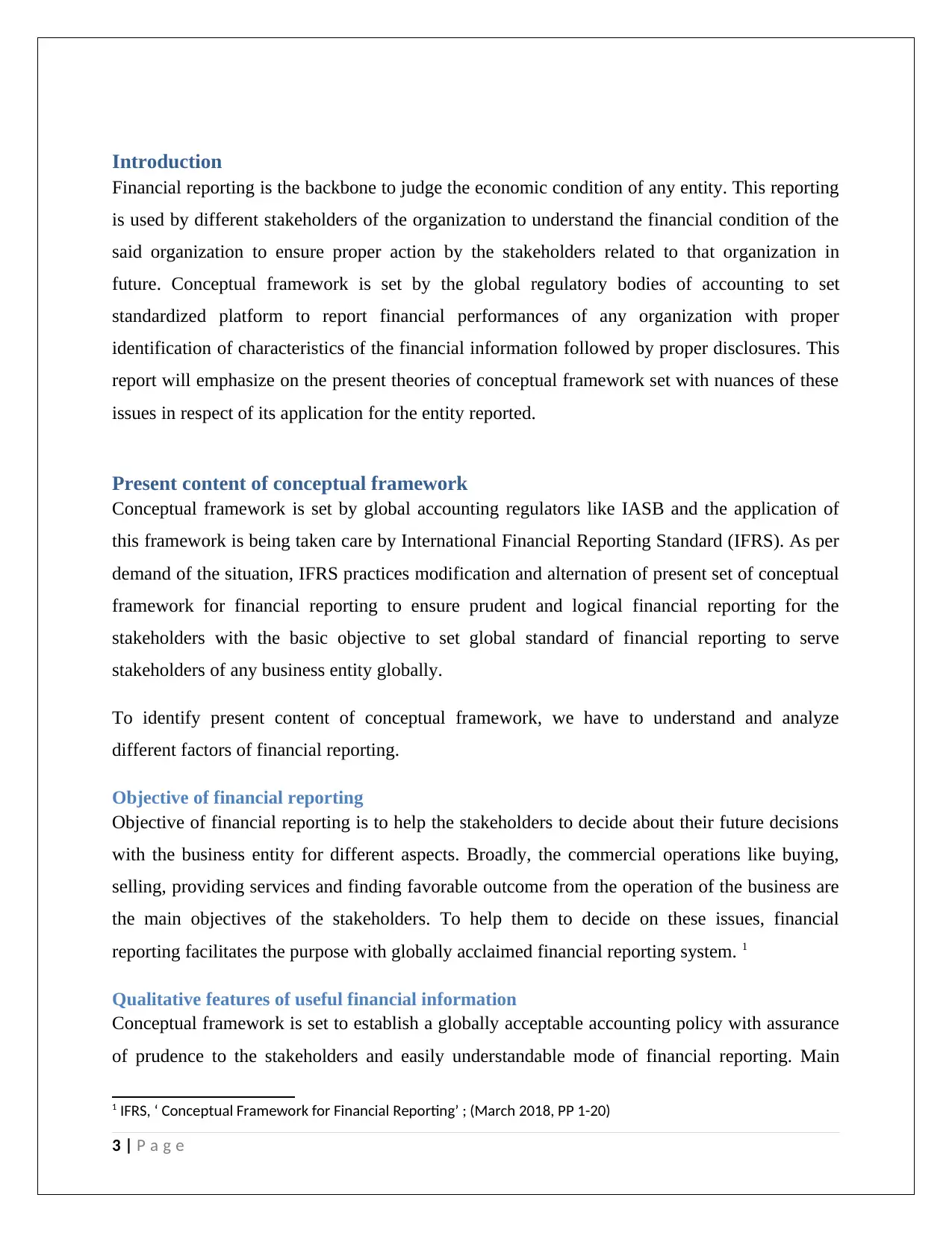
Introduction
Financial reporting is the backbone to judge the economic condition of any entity. This reporting
is used by different stakeholders of the organization to understand the financial condition of the
said organization to ensure proper action by the stakeholders related to that organization in
future. Conceptual framework is set by the global regulatory bodies of accounting to set
standardized platform to report financial performances of any organization with proper
identification of characteristics of the financial information followed by proper disclosures. This
report will emphasize on the present theories of conceptual framework set with nuances of these
issues in respect of its application for the entity reported.
Present content of conceptual framework
Conceptual framework is set by global accounting regulators like IASB and the application of
this framework is being taken care by International Financial Reporting Standard (IFRS). As per
demand of the situation, IFRS practices modification and alternation of present set of conceptual
framework for financial reporting to ensure prudent and logical financial reporting for the
stakeholders with the basic objective to set global standard of financial reporting to serve
stakeholders of any business entity globally.
To identify present content of conceptual framework, we have to understand and analyze
different factors of financial reporting.
Objective of financial reporting
Objective of financial reporting is to help the stakeholders to decide about their future decisions
with the business entity for different aspects. Broadly, the commercial operations like buying,
selling, providing services and finding favorable outcome from the operation of the business are
the main objectives of the stakeholders. To help them to decide on these issues, financial
reporting facilitates the purpose with globally acclaimed financial reporting system. 1
Qualitative features of useful financial information
Conceptual framework is set to establish a globally acceptable accounting policy with assurance
of prudence to the stakeholders and easily understandable mode of financial reporting. Main
1 IFRS, ‘ Conceptual Framework for Financial Reporting’ ; (March 2018, PP 1-20)
3 | P a g e
Financial reporting is the backbone to judge the economic condition of any entity. This reporting
is used by different stakeholders of the organization to understand the financial condition of the
said organization to ensure proper action by the stakeholders related to that organization in
future. Conceptual framework is set by the global regulatory bodies of accounting to set
standardized platform to report financial performances of any organization with proper
identification of characteristics of the financial information followed by proper disclosures. This
report will emphasize on the present theories of conceptual framework set with nuances of these
issues in respect of its application for the entity reported.
Present content of conceptual framework
Conceptual framework is set by global accounting regulators like IASB and the application of
this framework is being taken care by International Financial Reporting Standard (IFRS). As per
demand of the situation, IFRS practices modification and alternation of present set of conceptual
framework for financial reporting to ensure prudent and logical financial reporting for the
stakeholders with the basic objective to set global standard of financial reporting to serve
stakeholders of any business entity globally.
To identify present content of conceptual framework, we have to understand and analyze
different factors of financial reporting.
Objective of financial reporting
Objective of financial reporting is to help the stakeholders to decide about their future decisions
with the business entity for different aspects. Broadly, the commercial operations like buying,
selling, providing services and finding favorable outcome from the operation of the business are
the main objectives of the stakeholders. To help them to decide on these issues, financial
reporting facilitates the purpose with globally acclaimed financial reporting system. 1
Qualitative features of useful financial information
Conceptual framework is set to establish a globally acceptable accounting policy with assurance
of prudence to the stakeholders and easily understandable mode of financial reporting. Main
1 IFRS, ‘ Conceptual Framework for Financial Reporting’ ; (March 2018, PP 1-20)
3 | P a g e
⊘ This is a preview!⊘
Do you want full access?
Subscribe today to unlock all pages.

Trusted by 1+ million students worldwide
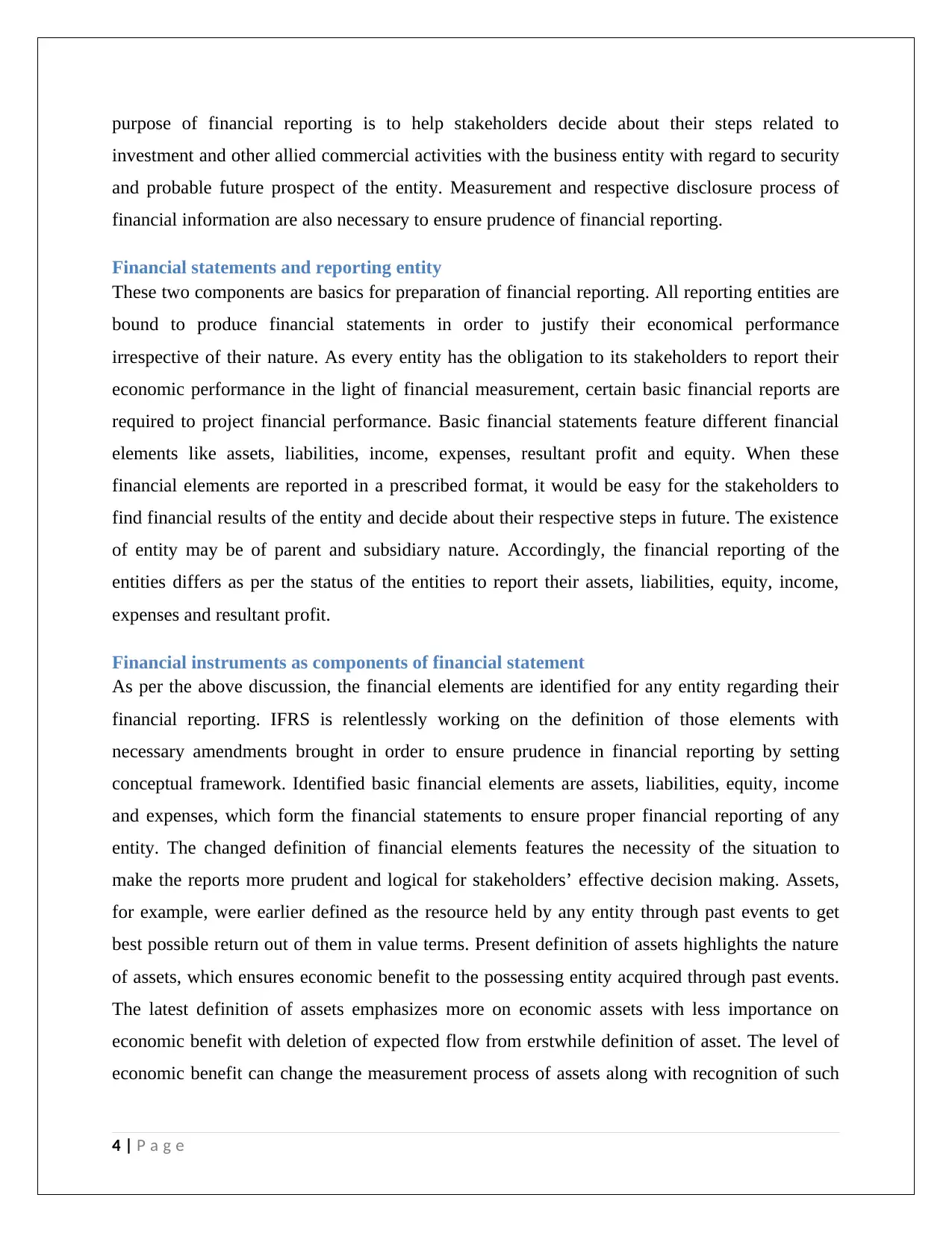
purpose of financial reporting is to help stakeholders decide about their steps related to
investment and other allied commercial activities with the business entity with regard to security
and probable future prospect of the entity. Measurement and respective disclosure process of
financial information are also necessary to ensure prudence of financial reporting.
Financial statements and reporting entity
These two components are basics for preparation of financial reporting. All reporting entities are
bound to produce financial statements in order to justify their economical performance
irrespective of their nature. As every entity has the obligation to its stakeholders to report their
economic performance in the light of financial measurement, certain basic financial reports are
required to project financial performance. Basic financial statements feature different financial
elements like assets, liabilities, income, expenses, resultant profit and equity. When these
financial elements are reported in a prescribed format, it would be easy for the stakeholders to
find financial results of the entity and decide about their respective steps in future. The existence
of entity may be of parent and subsidiary nature. Accordingly, the financial reporting of the
entities differs as per the status of the entities to report their assets, liabilities, equity, income,
expenses and resultant profit.
Financial instruments as components of financial statement
As per the above discussion, the financial elements are identified for any entity regarding their
financial reporting. IFRS is relentlessly working on the definition of those elements with
necessary amendments brought in order to ensure prudence in financial reporting by setting
conceptual framework. Identified basic financial elements are assets, liabilities, equity, income
and expenses, which form the financial statements to ensure proper financial reporting of any
entity. The changed definition of financial elements features the necessity of the situation to
make the reports more prudent and logical for stakeholders’ effective decision making. Assets,
for example, were earlier defined as the resource held by any entity through past events to get
best possible return out of them in value terms. Present definition of assets highlights the nature
of assets, which ensures economic benefit to the possessing entity acquired through past events.
The latest definition of assets emphasizes more on economic assets with less importance on
economic benefit with deletion of expected flow from erstwhile definition of asset. The level of
economic benefit can change the measurement process of assets along with recognition of such
4 | P a g e
investment and other allied commercial activities with the business entity with regard to security
and probable future prospect of the entity. Measurement and respective disclosure process of
financial information are also necessary to ensure prudence of financial reporting.
Financial statements and reporting entity
These two components are basics for preparation of financial reporting. All reporting entities are
bound to produce financial statements in order to justify their economical performance
irrespective of their nature. As every entity has the obligation to its stakeholders to report their
economic performance in the light of financial measurement, certain basic financial reports are
required to project financial performance. Basic financial statements feature different financial
elements like assets, liabilities, income, expenses, resultant profit and equity. When these
financial elements are reported in a prescribed format, it would be easy for the stakeholders to
find financial results of the entity and decide about their respective steps in future. The existence
of entity may be of parent and subsidiary nature. Accordingly, the financial reporting of the
entities differs as per the status of the entities to report their assets, liabilities, equity, income,
expenses and resultant profit.
Financial instruments as components of financial statement
As per the above discussion, the financial elements are identified for any entity regarding their
financial reporting. IFRS is relentlessly working on the definition of those elements with
necessary amendments brought in order to ensure prudence in financial reporting by setting
conceptual framework. Identified basic financial elements are assets, liabilities, equity, income
and expenses, which form the financial statements to ensure proper financial reporting of any
entity. The changed definition of financial elements features the necessity of the situation to
make the reports more prudent and logical for stakeholders’ effective decision making. Assets,
for example, were earlier defined as the resource held by any entity through past events to get
best possible return out of them in value terms. Present definition of assets highlights the nature
of assets, which ensures economic benefit to the possessing entity acquired through past events.
The latest definition of assets emphasizes more on economic assets with less importance on
economic benefit with deletion of expected flow from erstwhile definition of asset. The level of
economic benefit can change the measurement process of assets along with recognition of such
4 | P a g e
Paraphrase This Document
Need a fresh take? Get an instant paraphrase of this document with our AI Paraphraser
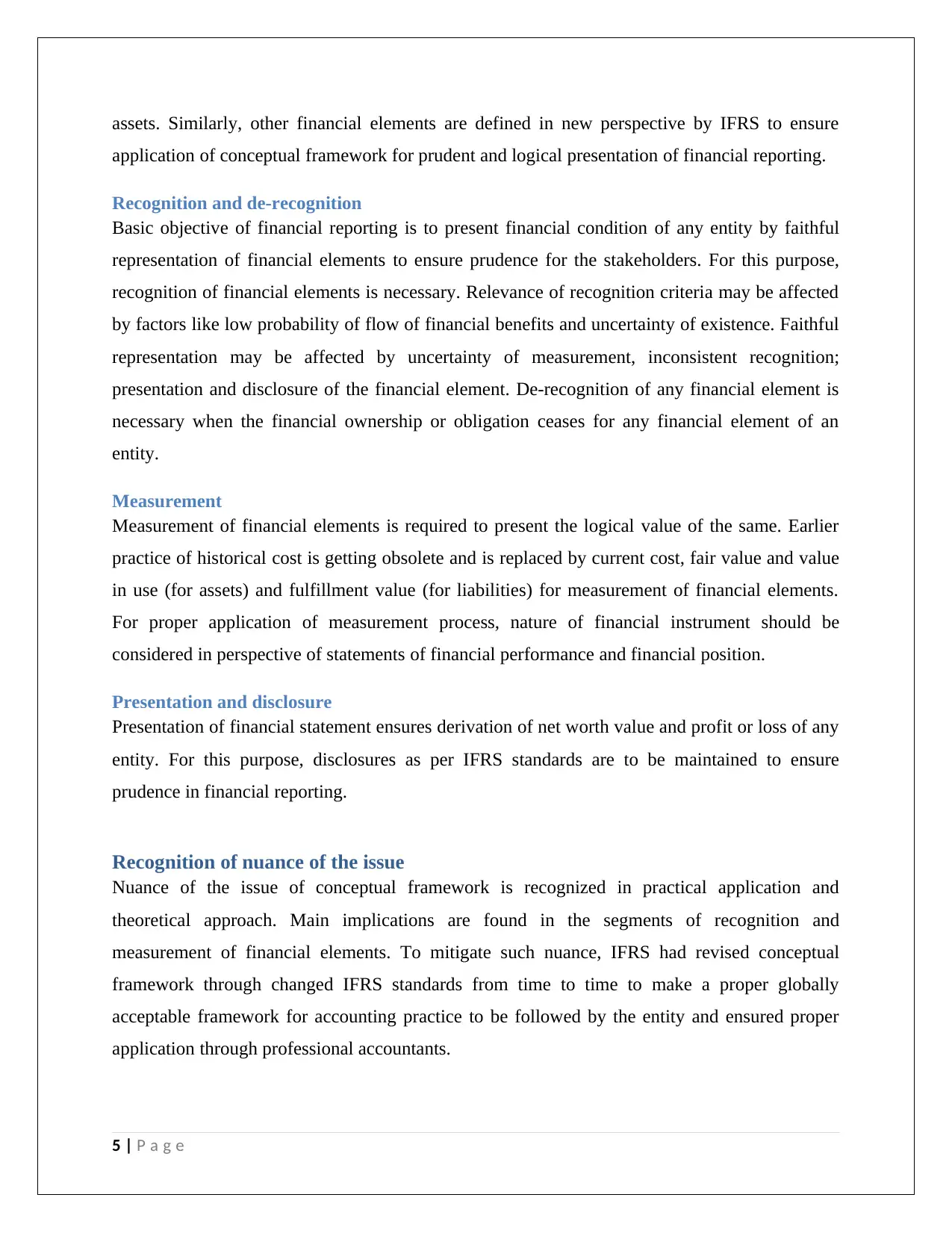
assets. Similarly, other financial elements are defined in new perspective by IFRS to ensure
application of conceptual framework for prudent and logical presentation of financial reporting.
Recognition and de-recognition
Basic objective of financial reporting is to present financial condition of any entity by faithful
representation of financial elements to ensure prudence for the stakeholders. For this purpose,
recognition of financial elements is necessary. Relevance of recognition criteria may be affected
by factors like low probability of flow of financial benefits and uncertainty of existence. Faithful
representation may be affected by uncertainty of measurement, inconsistent recognition;
presentation and disclosure of the financial element. De-recognition of any financial element is
necessary when the financial ownership or obligation ceases for any financial element of an
entity.
Measurement
Measurement of financial elements is required to present the logical value of the same. Earlier
practice of historical cost is getting obsolete and is replaced by current cost, fair value and value
in use (for assets) and fulfillment value (for liabilities) for measurement of financial elements.
For proper application of measurement process, nature of financial instrument should be
considered in perspective of statements of financial performance and financial position.
Presentation and disclosure
Presentation of financial statement ensures derivation of net worth value and profit or loss of any
entity. For this purpose, disclosures as per IFRS standards are to be maintained to ensure
prudence in financial reporting.
Recognition of nuance of the issue
Nuance of the issue of conceptual framework is recognized in practical application and
theoretical approach. Main implications are found in the segments of recognition and
measurement of financial elements. To mitigate such nuance, IFRS had revised conceptual
framework through changed IFRS standards from time to time to make a proper globally
acceptable framework for accounting practice to be followed by the entity and ensured proper
application through professional accountants.
5 | P a g e
application of conceptual framework for prudent and logical presentation of financial reporting.
Recognition and de-recognition
Basic objective of financial reporting is to present financial condition of any entity by faithful
representation of financial elements to ensure prudence for the stakeholders. For this purpose,
recognition of financial elements is necessary. Relevance of recognition criteria may be affected
by factors like low probability of flow of financial benefits and uncertainty of existence. Faithful
representation may be affected by uncertainty of measurement, inconsistent recognition;
presentation and disclosure of the financial element. De-recognition of any financial element is
necessary when the financial ownership or obligation ceases for any financial element of an
entity.
Measurement
Measurement of financial elements is required to present the logical value of the same. Earlier
practice of historical cost is getting obsolete and is replaced by current cost, fair value and value
in use (for assets) and fulfillment value (for liabilities) for measurement of financial elements.
For proper application of measurement process, nature of financial instrument should be
considered in perspective of statements of financial performance and financial position.
Presentation and disclosure
Presentation of financial statement ensures derivation of net worth value and profit or loss of any
entity. For this purpose, disclosures as per IFRS standards are to be maintained to ensure
prudence in financial reporting.
Recognition of nuance of the issue
Nuance of the issue of conceptual framework is recognized in practical application and
theoretical approach. Main implications are found in the segments of recognition and
measurement of financial elements. To mitigate such nuance, IFRS had revised conceptual
framework through changed IFRS standards from time to time to make a proper globally
acceptable framework for accounting practice to be followed by the entity and ensured proper
application through professional accountants.
5 | P a g e

6 | P a g e
⊘ This is a preview!⊘
Do you want full access?
Subscribe today to unlock all pages.

Trusted by 1+ million students worldwide
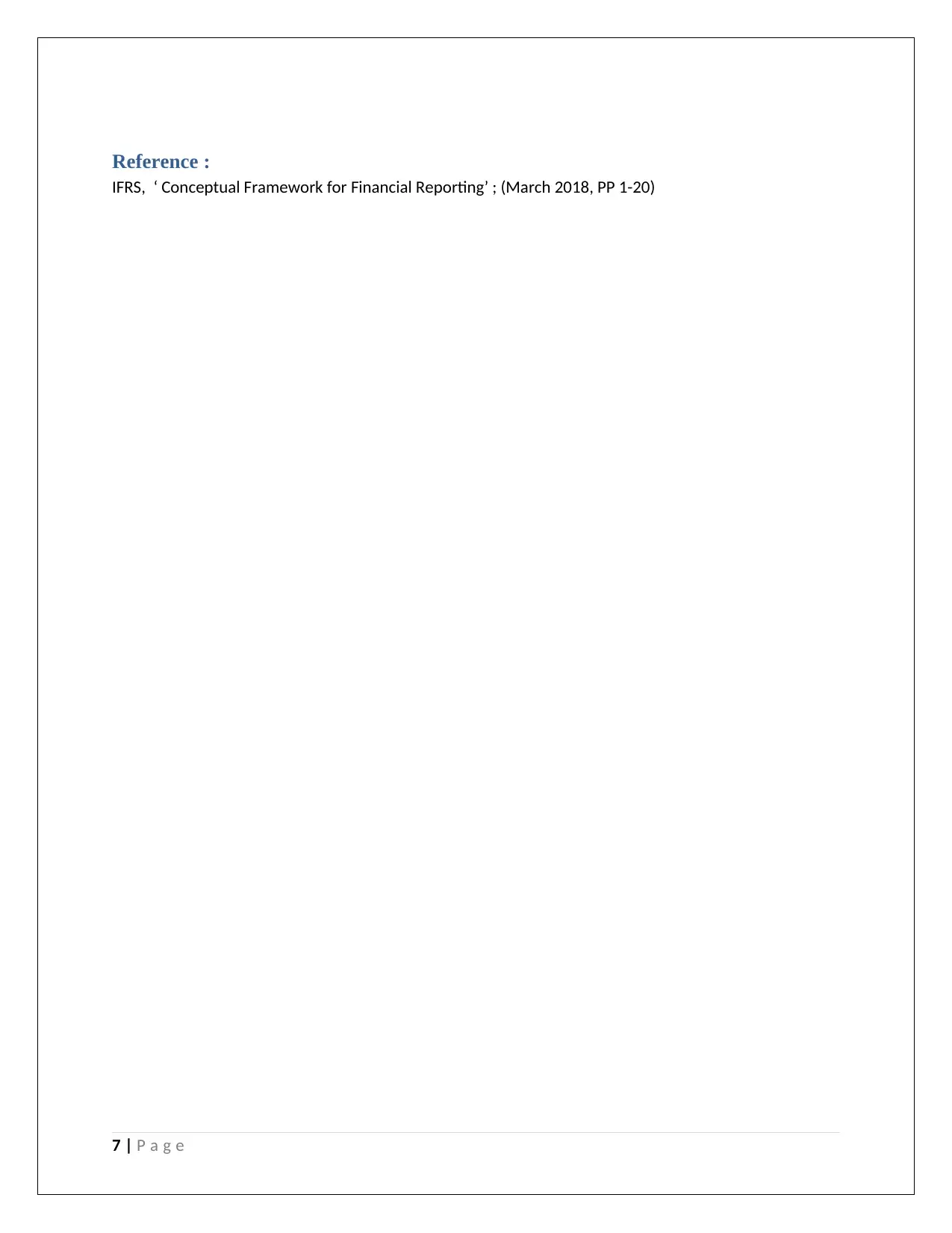
Reference :
IFRS, ‘ Conceptual Framework for Financial Reporting’ ; (March 2018, PP 1-20)
7 | P a g e
IFRS, ‘ Conceptual Framework for Financial Reporting’ ; (March 2018, PP 1-20)
7 | P a g e
1 out of 7
Related Documents
Your All-in-One AI-Powered Toolkit for Academic Success.
+13062052269
info@desklib.com
Available 24*7 on WhatsApp / Email
![[object Object]](/_next/static/media/star-bottom.7253800d.svg)
Unlock your academic potential
Copyright © 2020–2025 A2Z Services. All Rights Reserved. Developed and managed by ZUCOL.





